Sine and cosine
| Sine and cosine | |
|---|---|
 | |
| General information | |
| General definition | |
| Fields of application | Trigonometry,Fourier series,etc. |
| Trigonometry |
|---|
 |
| Reference |
| Laws and theorems |
| Calculus |
| Mathematicians |
Inmathematics,sineandcosinearetrigonometric functionsof anangle.The sine and cosine of an acuteangleare defined in the context of aright triangle:for the specified angle, its sine is the ratio of the length of the side that is opposite that angle to the length of the longest side of thetriangle(thehypotenuse), and the cosine is theratioof the length of the adjacent leg to that of thehypotenuse.For an angle,the sine and cosine functions are denoted asand.[1]
The definitions of sine and cosine have been extended to anyrealvalue in terms of the lengths of certain line segments in aunit circle.More modern definitions express the sine and cosine asinfinite series,or as the solutions of certaindifferential equations,allowing their extension to arbitrary positive and negative values and even tocomplex numbers.
The sine and cosine functions are commonly used to modelperiodicphenomena such assoundandlight waves,the position and velocity of harmonic oscillators, sunlight intensity and day length, and average temperature variations throughout the year. They can be traced to thejyāandkoṭi-jyāfunctions used inIndian astronomyduring theGupta period.
Notation[edit]
Sine and cosine are written usingfunctional notationwith the abbreviationssinandcos.
Often, if the argument is simple enough, the function value will be written without parentheses, assinθrather than assin(θ).
Each of sine and cosine is a function of an angle, which is usually expressed in terms ofradiansordegrees.Except where explicitly stated otherwise, this article assumes that the angle is measured in radians.
Definitions[edit]
Right-angled triangle definitions[edit]

To define the sine and cosine of an acute angleα,start with aright trianglethat contains an angle of measureα;in the accompanying figure, angleαin triangleABCis the angle of interest. The three sides of the triangle are named as follows:
- Theopposite sideis the side opposite to the angle of interest, in this case sidea.
- Thehypotenuseis the side opposite the right angle, in this case sideh.The hypotenuse is always the longest side of a right-angled triangle.
- Theadjacent sideis the remaining side, in this case sideb.It forms a side of (and is adjacent to) both the angle of interest (angleA) and the right angle.
Once such a triangle is chosen, the sine of the angle is equal to the length of the opposite side, divided by the length of the hypotenuse:[2]
The other trigonometric functions of the angle can be defined similarly; for example, thetangentis the ratio between the opposite and adjacent sides.[2]
As stated, the valuesandappear to depend on the choice of right triangle containing an angle of measureα.However, this is not the case: all such triangles aresimilar,and so the ratios are the same for each of them.
Unit circle definitions[edit]
Intrigonometry,aunit circleis the circle of radius one centered at the origin (0, 0) in theCartesian coordinate system.
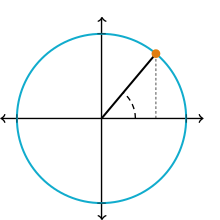
Let a line through the origin intersect the unit circle, making an angle ofθwith the positive half of thex-axis. Thex- andy-coordinates of this point of intersection are equal tocos(θ)andsin(θ),respectively. This definition is consistent with the right-angled triangle definition of sine and cosine when:because the length of the hypotenuse of the unit circle is always 1,.The length of the opposite side of the triangle is simply they-coordinate. A similar argument can be made for the cosine function to show thatwhen,even under the new definition using the unit circle.tan(θ)is then defined as,or, equivalently, as the slope of the line segment.
Using the unit circle definition has the advantage that the angle can be extended to any real argument. This can also be achieved by requiring certain symmetries, and that sine be aperiodic function.
Complex exponential function definitions[edit]
Theexponential functionis defined on the entire domain of thecomplex numbers.The definition of sine and cosine can be extended to all complex numbers via
These can be reversed to giveEuler's formula
When plotted on thecomplex plane,the functionfor real values oftraces out theunit circlein the complex plane.
Whenis a real number, sine and cosine simplify to the imaginary and real parts ofor,as:
Whenfor real valuesand,sine and cosine can be expressed in terms of real sines, cosines, andhyperbolic functionsas
Differential equation definition[edit]
is the solutionto the two-dimensional system ofdifferential equationsandwith theinitial conditionsand.One could interpret the unit circle in the above definitions as defining thephase space trajectoryof the differential equation with the given initial conditions.
-
Animation demonstrating how the sine function (in red) is graphed from they-coordinate (red dot) of a point on theunit circle(in green), at an angle ofθ.The cosine (in blue) is thex-coordinate.
It can be interpreted as a phase space trajectory of the system of differential equationsandstarting from the initial conditionsand.
Series definitions[edit]


The successive derivatives of sine, evaluated at zero, can be used to determine its Taylor series. Using only geometry and properties oflimits,it can be shown that thederivativeof sine is cosine, and that the derivative of cosine is the negative of sine. This means the successive derivatives of sin(x) are cos(x), -sin(x), -cos(x), sin(x), continuing to repeat those four functions. The (4n+k)-th derivative, evaluated at the point 0:
where the superscript represents repeated differentiation. This implies the following Taylor series expansion at x = 0. One can then use the theory ofTaylor seriesto show that the following identities hold for allreal numbersx(where x is the angle in radians), and more generally for allcomplex numbers:[3]
Taking the derivative of each term gives the Taylor series for cosine:
These Taylor series provide explicit,computable,definitions of sine and cosine in terms ofelementary arithmeticoperations.
Continued fraction definitions[edit]
The sine function can also be represented as ageneralized continued fraction:
The continued fraction representations can be derived fromEuler's continued fraction formulaand express thereal numbervalues, bothrationalandirrational,of the sine and cosine functions.
Identities[edit]
Exact identities (usingradians):
These apply for all values of.
Reciprocals[edit]
Thereciprocalof sine is cosecant, i.e., the reciprocal ofis.Cosecant gives the ratio of the length of the hypotenuse to the length of the opposite side. Similarly, the reciprocal of cosine is secant, which gives the ratio of the length of the hypotenuse to that of the adjacent side.
Inverses[edit]

Theinverse functionof sine is arcsine (arcsin or asin) or inverse sine (sin−1). The inverse function of cosine is arccosine (arccos, acos, orcos−1). (The superscript of −1 insin−1andcos−1denotes the inverse of a function, notexponentiation.) As sine and cosine are notinjective,their inverses are not exact inverse functions, but partial inverse functions. For example,sin(0) = 0,but alsosin(π) = 0,sin(2π) = 0etc. It follows that the arcsine function is multivalued:arcsin(0) = 0,but alsoarcsin(0) =π,arcsin(0) = 2π,etc. When only one value is desired, the function may be restricted to itsprincipal branch.With this restriction, for eachxin the domain, the expressionarcsin(x)will evaluate only to a single value, called itsprincipal value.The standard range of principal values for arcsin is from−π/2toπ/2and the standard range for arccos is from0toπ.
where (for some integerk):
By definition, arcsin and arccos satisfy the equations:
and
Pythagorean trigonometric identity[edit]
The basic relationship between the sine and the cosine is thePythagorean trigonometric identity:[1]
where sin2(x) means (sin(x))2.
Double angle formulas[edit]
Sine and cosine satisfy the following double angle formulas:

The cosine double angle formula implies that sin2and cos2are, themselves, shifted and scaled sine waves. Specifically,[4]
The graph shows both the sine function and thesine squaredfunction, with the sine in blue and sine squared in red. Both graphs have the same shape, but with different ranges of values, and different periods. Sine squared has only positive values, but twice the number of periods.
Derivative and integrals[edit]
The derivatives of sine and cosine are:
and their antiderivatives are:
whereCdenotes theconstant of integration.[1]
Properties relating to the quadrants[edit]

The table below displays many of the key properties of the sine function (sign, monotonicity, convexity), arranged by the quadrant of the argument. For arguments outside those in the table, one may compute the corresponding information by using the periodicityof the sine function.
| Quadrant | Angle | Sine | Cosine | |||||
|---|---|---|---|---|---|---|---|---|
| Degrees | Radians | Sign | Monotony | Convexity | Sign | Monotony | Convexity | |
| 1st quadrant, I | increasing | concave | decreasing | concave | ||||
| 2nd quadrant, II | decreasing | concave | decreasing | convex | ||||
| 3rd quadrant, III | decreasing | convex | increasing | convex | ||||
| 4th quadrant, IV | increasing | convex | increasing | concave | ||||

The following table gives basic information at the boundary of the quadrants.
| Degrees | Radians | ||||
|---|---|---|---|---|---|
| Value | Point type | Value | Point type | ||
| Root,inflection | Maximum | ||||
| Maximum | Root,inflection | ||||
| Root,inflection | Minimum | ||||
| Minimum | Root,inflection | ||||
Fixed points[edit]

Zero is the only realfixed pointof the sine function; in other words the only intersection of the sine function and theidentity functionis.The only real fixed point of the cosine function is called theDottie number.That is, the Dottie number is the unique real root of the equationThe decimal expansion of the Dottie number is.[5]
Arc length[edit]
Thearc lengthof the sine curve betweenandis
whereis theincomplete elliptic integral of the second kindwith modulus.It cannot be expressed usingelementary functions.
The arc length for a full period is[6]
whereis thegamma functionandis thelemniscate constant.[6][7]
Laws[edit]
Thelaw of sinesstates that for an arbitrary triangle with sidesa,b,andcand angles opposite those sidesA,BandC:
This is equivalent to the equality of the first three expressions below:
whereRis the triangle'scircumradius.
It can be proved by dividing the triangle into two right ones and using the above definition of sine. The law of sines is useful for computing the lengths of the unknown sides in a triangle if two angles and one side are known. This is a common situation occurring intriangulation,a technique to determine unknown distances by measuring two angles and an accessible enclosed distance.
Thelaw of cosinesstates that for an arbitrary triangle with sidesa,b,andcand angles opposite those sidesA,BandC:
In the case where,and this becomes thePythagorean theorem:for a right triangle,wherecis the hypotenuse.
Special values[edit]

Forinteger multiplesof 15° (that is,radians), the values of sin(x) and cos(x) are particularly simple and can be expressed in terms ofonly. A table of these angles is given below. For more complex angle expressions seeExact trigonometric values § Common angles.
| Angle,x | sin(x) | cos(x) | |||||
|---|---|---|---|---|---|---|---|
| Degrees | Radians | Gradians | Turns | Exact | Decimal | Exact | Decimal |
| 0° | 0 | 0g | 0 | 0 | 0 | 1 | 1 |
| 15° | 1/12π | 16+2/3g | 1/24 | 0.2588 | 0.9659 | ||
| 30° | 1/6π | 33+1/3g | 1/12 | 1/2 | 0.5 | 0.8660 | |
| 45° | 1/4π | 50g | 1/8 | 0.7071 | 0.7071 | ||
| 60° | 1/3π | 66+2/3g | 1/6 | 0.8660 | 1/2 | 0.5 | |
| 75° | 5/12π | 83+1/3g | 5/24 | 0.9659 | 0.2588 | ||
| 90° | 1/2π | 100g | 1/4 | 1 | 1 | 0 | 0 |
90 degree increments:
| xin degrees | 0° | 90° | 180° | 270° | 360° |
|---|---|---|---|---|---|
| xin radians | 0 | π/2 | π | 3π/2 | 2π |
| xingons | 0 | 100g | 200g | 300g | 400g |
| xin turns | 0 | 1/4 | 1/2 | 3/4 | 1 |
| sinx | 0 | 1 | 0 | −1 | 0 |
| cosx | 1 | 0 | −1 | 0 | 1 |
Relationship to complex numbers[edit]

Sine and cosine are used to connect the real and imaginary parts of acomplex numberwith itspolar coordinates(r,φ):
The real and imaginary parts are:
whererandφrepresent the magnitude and angle of the complex numberz.
For any real numberθ,Euler's formulasays that:
Therefore, if the polar coordinates ofzare (r,φ),
Complex arguments[edit]


Applying the series definition of the sine and cosine to a complex argument,z,gives:
where sinh and cosh are thehyperbolic sine and cosine.These areentire functions.
It is also sometimes useful to express the complex sine and cosine functions in terms of the real and imaginary parts of its argument:
Partial fraction and product expansions of complex sine[edit]
Using the partial fraction expansion technique incomplex analysis,one can find that the infinite series
both converge and are equal to.Similarly, one can show that
Using product expansion technique, one can derive
Alternatively, the infinite product for the sine can be proved usingcomplex Fourier series.
Proof of the infinite product for the sine
|
|---|
|
Using complex Fourier series, the functioncan be decomposed as Settingyields Therefore, we get The functionis the derivative of.Furthermore, if,then the functionsuch that the emerged series converges on some open and connected subset ofis,which can be proved using theWeierstrass M-test.The interchange of the sum and derivative is justified byuniform convergence.It follows that Exponentiating gives Sinceand,we have.Hence for some open and connected subset of.Let.Sinceconverges uniformly on any closed disk,converges uniformly on any closed disk as well.[8]It follows that the infinite product is holomorphic on.By theidentity theorem,the infinite product for the sine is valid for all,which completes the proof. |
Usage of complex sine[edit]
sin(z) is found in thefunctional equationfor theGamma function,
which in turn is found in thefunctional equationfor theRiemann zeta-function,
As aholomorphic function,sinzis a 2D solution ofLaplace's equation:
The complex sine function is also related to the level curves ofpendulums.[how?][9][better source needed]
Complex graphs[edit]
 |
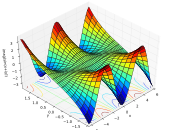 |
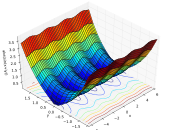 |
| real component | imaginary component | magnitude |
 |
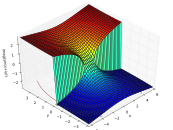 |
 |
| real component | imaginary component | magnitude |
History[edit]

While the early study of trigonometry can be traced to antiquity, thetrigonometric functionsas they are in use today were developed in the medieval period. Thechordfunction was discovered byHipparchusofNicaea(180–125 BCE) andPtolemyofRoman Egypt(90–165 CE).[10]
The sine and cosine functions can be traced to thejyāandkoṭi-jyāfunctions used inIndian astronomyduring theGupta period(AryabhatiyaandSurya Siddhanta), via translation from Sanskrit to Arabic and then from Arabic to Latin.[11]
All six trigonometric functions in current use were known inIslamic mathematicsby the 9th century, as was thelaw of sines,used insolving triangles.[12]With the exception of the sine (which was adopted from Indian mathematics), the other five modern trigonometric functions were discovered by Arabic mathematicians, including the cosine, tangent, cotangent, secant and cosecant.[12]Al-Khwārizmī(c. 780–850) produced tables of sines, cosines and tangents.[13][14]Muhammad ibn Jābir al-Harrānī al-Battānī(853–929) discovered the reciprocal functions of secant and cosecant, and produced the first table of cosecants for each degree from 1° to 90°.[14]
The first published use of the abbreviationssin,cos,andtanis by the 16th-century French mathematicianAlbert Girard;these were further promulgated by Euler (see below). TheOpus palatinum de triangulisofGeorg Joachim Rheticus,a student ofCopernicus,was probably the first in Europe to define trigonometric functions directly in terms of right triangles instead of circles, with tables for all six trigonometric functions; this work was finished by Rheticus' student Valentin Otho in 1596.
In a paper published in 1682,Leibnizproved that sinxis not analgebraic functionofx.[15]Roger Cotescomputed the derivative of sine in hisHarmonia Mensurarum(1722).[16]Leonhard Euler'sIntroductio in analysin infinitorum(1748) was mostly responsible for establishing the analytic treatment of trigonometric functions in Europe, also defining them as infinite series and presenting "Euler's formula",as well as the near-modern abbreviationssin.,cos.,tang.,cot.,sec.,andcosec.[11]
Etymology[edit]
The wordsineis derived, indirectly, from theSanskritwordjyā'bow-string'[17][18] or more specifically its synonymjīvá(both adopted fromAncient Greekχορδή'string'[19]), due to visual similarity between the arc of a circle with its corresponding chord and a bow with its string (seejyā, koti-jyā and utkrama-jyā). This wastransliteratedinArabicasjība,which is meaningless in that language and written asjb(جب). Since Arabic is written without short vowels,jbwas interpreted as thehomographjayb(جيب), which means 'bosom', 'pocket', or 'fold'. When the Arabic texts ofAl-Battaniandal-Khwārizmīwere translated intoMedieval Latinin the 12th century byGerard of Cremona,he used the Latin equivalentsinus(which also means 'bay' or 'fold', and more specifically 'the hanging fold of atogaover the breast').[11][20][21]Gerard was probably not the first scholar to use this translation; Robert of Chester appears to have preceded him and there is evidence of even earlier usage.[22][23]The English formsinewas introduced in the 1590s.[24]
The wordcosinederives from an abbreviation of the Latincomplementi sinus'sine of thecomplementary angle' ascosinusinEdmund Gunter'sCanon triangulorum(1620), which also includes a similar definition ofcotangens.[25][26][27]
Software implementations[edit]
There is no standard algorithm for calculating sine and cosine.IEEE 754,the most widely used standard for the specification of reliable floating-point computation, does not address calculating trigonometric functions such as sine. The reason is that no efficient algorithm is known for computing sine and cosine with a specified accuracy, especially for large inputs.[28]
Algorithms for calculating sine may be balanced for such constraints as speed, accuracy, portability, or range of input values accepted. This can lead to different results for different algorithms, especially for special circumstances such as very large inputs, e.g.sin(1022).
A common programming optimization, used especially in 3D graphics, is to pre-calculate a table of sine values, for example one value per degree, then for values in-between pick the closest pre-calculated value, orlinearly interpolatebetween the 2 closest values to approximate it. This allows results to be looked up from a table rather than being calculated in real time. With modern CPU architectures this method may offer no advantage.[citation needed]
TheCORDICalgorithm is commonly used in scientific calculators.
The sine and cosine functions, along with other trigonometric functions, are widely available across programming languages and platforms. In computing, they are typically abbreviated tosinandcos.
Some CPU architectures have a built-in instruction for sine, including the Intel x87 FPUs since the 80387.
In programming languages,sinandcosare typically either a built-in function or found within the language's standard math library.
For example, theC standard librarydefines sine functions withinmath.h:sin(double),sinf(float),andsinl(long double).The parameter of each is afloating pointvalue, specifying the angle in radians. Each function returns the samedata typeas it accepts. Many other trigonometric functions are also defined inmath.h,such as for cosine, arc sine, and hyperbolic sine (sinh).
Similarly,Pythondefinesmath.sin(x)andmath.cos(x)within the built-inmathmodule. Complex sine and cosine functions are also available within thecmathmodule, e.g.cmath.sin(z).CPython's math functions call theCmathlibrary, and use adouble-precision floating-point format.
Turns based implementations[edit]
Some software libraries provide implementations of sine and cosine using the input angle in half-turns,a half-turn being an angle of 180 degrees orradians. Representing angles in turns or half-turns has accuracy advantages and efficiency advantages in some cases.[29][30]In MATLAB, OpenCL, R, Julia, CUDA, and ARM, these functions are calledsinpiandcospi.[29][31][30][32][33][34]For example,sinpi(x)would evaluate towherexis expressed in half-turns, and consequently the final input to the function,πxcan be interpreted in radians bysin.
The accuracy advantage stems from the ability to perfectly represent key angles like full-turn, half-turn, and quarter-turn losslessly in binary floating-point or fixed-point. In contrast, representing,,andin binary floating-point or binary scaled fixed-point always involves a loss of accuracy since irrational numbers cannot be represented with finitely many binary digits.
Turns also have an accuracy advantage and efficiency advantage for computing modulo to one period. Computing modulo 1 turn or modulo 2 half-turns can be losslessly and efficiently computed in both floating-point and fixed-point. For example, computing modulo 1 or modulo 2 for a binary point scaled fixed-point value requires only a bit shift or bitwise AND operation. In contrast, computing moduloinvolves inaccuracies in representing.
For applications involving angle sensors, the sensor typically provides angle measurements in a form directly compatible with turns or half-turns. For example, an angle sensor may count from 0 to 4096 over one complete revolution.[35]If half-turns are used as the unit for angle, then the value provided by the sensor directly and losslessly maps to a fixed-point data type with 11 bits to the right of the binary point. In contrast, if radians are used as the unit for storing the angle, then the inaccuracies and cost of multiplying the raw sensor integer by an approximation towould be incurred.
See also[edit]
- Āryabhaṭa's sine table
- Bhaskara I's sine approximation formula
- Discrete sine transform
- Dixon elliptic functions
- Euler's formula
- Generalized trigonometry
- Hyperbolic function
- Lemniscate elliptic functions
- Law of sines
- List of periodic functions
- List of trigonometric identities
- Madhava series
- Madhava's sine table
- Optical sine theorem
- Polar sine—a generalization to vertex angles
- Proofs of trigonometric identities
- Sinc function
- Sine and cosine transforms
- Sine integral
- Sine quadrant
- Sine wave
- Sine–Gordon equation
- Sinusoidal model
- SOH-CAH-TOA
- Trigonometric functions
- Trigonometric integral
Citations[edit]
- ^abcWeisstein, Eric W."Sine".mathworld.wolfram.Retrieved2020-08-29.
- ^abYoung, Cynthia(2017).Trigonometry.John Wiley & Sons. p. 27.ISBN978-1-119-32113-2.
- ^Ahlfors, Lars(January 1, 1979).Complex Analysis(3 ed.). pp. 43–44.
- ^"Sine-squared function".RetrievedAugust 9,2019.
- ^"OEIS A003957".oeis.org.Retrieved2019-05-26.
- ^ab"A105419 - Oeis".
- ^Adlaj, Semjon (2012)."An Eloquent Formula for the Perimeter of an Ellipse"(PDF).American Mathematical Society.p. 1097.
- ^Rudin, Walter (1987).Real and Complex Analysis(Third ed.). McGraw-Hill Book Company.ISBN0-07-100276-6.p. 299, Theorem 15.4
- ^"Why are the phase portrait of the simple plane pendulum and a domain coloring of sin(z) so similar?".math.stackexchange.Retrieved2019-08-12.
- ^Brendan, T. (February 1965). "How Ptolemy constructed trigonometry tables".The Mathematics Teacher.58(2): 141–149.doi:10.5951/MT.58.2.0141.JSTOR27967990– via JSTOR.
- ^abcMerzbach, Uta C.;Boyer, Carl B.(2011),A History of Mathematics(3rd ed.), John Wiley & Sons:It was Robert of Chester's translation from the Arabic that resulted in our word "sine". The Hindus had given the name jiva to the half-chord in trigonometry, and the Arabs had taken this over as jiba. In the Arabic language there is also the word jaib meaning "bay" or "inlet". When Robert of Chester came to translate the technical word jiba, he seems to have confused this with the word jaib (perhaps because vowels were omitted); hence, he used the word sinus, the Latin word for "bay" or "inlet".
- ^abGingerich, Owen (1986)."Islamic Astronomy".Scientific American.Vol. 254. p. 74. Archived fromthe originalon 2013-10-19.Retrieved2010-07-13.
- ^Jacques Sesiano, "Islamic mathematics", p. 157, inSelin, Helaine;D'Ambrosio, Ubiratan,eds. (2000).Mathematics Across Cultures: The History of Non-western Mathematics.Springer Science+Business Media.ISBN978-1-4020-0260-1.
- ^ab"trigonometry".Encyclopedia Britannica. 17 June 2024.
- ^Nicolás Bourbaki (1994).Elements of the History of Mathematics.Springer.ISBN9783540647676.
- ^"Why the sine has a simple derivativeArchived2011-07-20 at theWayback Machine",inHistorical Notes for Calculus TeachersArchived2011-07-20 at theWayback MachinebyV. Frederick RickeyArchived2011-07-20 at theWayback Machine
- ^"How the Trig Functions Got their Names".Ask Dr. Math.Drexel University.Retrieved2 March2010.
- ^J J O'Connor and E F Robertson (June 1996)."The trigonometric functions".Retrieved2 March2010.
- ^See Plofker,Mathematics in India,Princeton University Press, 2009, p. 257
See"Clark University".Archivedfrom the original on 15 June 2008.
See Maor (1998), chapter 3, regarding the etymology. - ^Eli Maor (1998),Trigonometric Delights,Princeton: Princeton University Press, p. 35-36.
- ^Victor J. Katz (2008),A History of Mathematics,Boston: Addison-Wesley, 3rd. ed., p. 253, sidebar 8.1."A History of Mathematics"(PDF).Archived(PDF)from the original on 2015-04-14.Retrieved2015-04-09.:The English word “sine” comes from a series of mistranslations of the Sanskritjyā-ardha(chord-half). Āryabhaṭa frequently abbreviated this term tojyāor its synonymjīvá.When some of the Hindu works were later translated into Arabic, the word was simply transcribed phonetically into an otherwise meaningless Arabic wordjiba.But since Arabic is written without vowels, later writers interpreted the consonantsjbasjaib,which means bosom or breast. In the twelfth century, when an Arabic trigonometry work was translated into Latin, the translator used the equivalent Latin wordsinus,which also meant bosom, and by extension, fold (as in a toga over a breast), or a bay or gulf.
- ^Smith, D.E. (1958) [1925],History of Mathematics,vol. I, Dover, p. 202,ISBN0-486-20429-4
- ^Various sources credit the first use ofsinusto either
- Plato Tiburtinus's 1116 translation of theAstronomyofAl-Battani
- Gerard of Cremona's translation of theAlgebraofal-Khwārizmī
- Robert of Chester's 1145 translation of the tables of al-Khwārizmī
See Maor (1998), chapter 3, for an earlier etymology crediting Gerard.
SeeKatx, Victor (July 2008).A history of mathematics(3rd ed.). Boston:Pearson.p. 210 (sidebar).ISBN978-0321387004. - ^The anglicized form is first recorded in 1593 inThomas Fale'sHorologiographia, the Art of Dialling.
- ^Gunter, Edmund(1620).Canon triangulorum.
- ^Roegel, Denis, ed. (6 December 2010)."A reconstruction of Gunter's Canon triangulorum (1620)"(Research report). HAL. inria-00543938.Archivedfrom the original on 28 July 2017.Retrieved28 July2017.
- ^"cosine".
- ^Zimmermann, Paul (2006), "Can we trust floating-point numbers?",Grand Challenges of Informatics(PDF),p. 14/31,archived(PDF)from the original on 2011-07-16,retrieved2010-09-11
- ^ab"MATLAB Documentation sinpi
- ^ab"R Documentation sinpi
- ^"OpenCL Documentation sinpi
- ^"Julia Documentation sinpi
- ^"CUDA Documentation sinpi
- ^"ARM Documentation sinpi
- ^"ALLEGRO Angle Sensor DatasheetArchived2019-04-17 at theWayback Machine
References[edit]
- Traupman, Ph.D., John C. (1966),The New College Latin & English Dictionary,Toronto: Bantam,ISBN0-553-27619-0
- Webster's Seventh New Collegiate Dictionary,Springfield: G. & C. Merriam Company, 1969
External links[edit]
 Media related toSine functionat Wikimedia Commons
Media related toSine functionat Wikimedia Commons

![{\displaystyle {\begin{aligned}&\sin(\alpha )={\frac {\textrm {opposite}}{\textrm {hypotenuse}}}\\[8pt]&\cos(\alpha )={\frac {\textrm {adjacent}}{\textrm {hypotenuse}}}\\[8pt]\end{aligned}}}](https://wikimedia.org/api/rest_v1/media/math/render/svg/ea2762f231f5fdc1dcfacd59c303106f596ab2e1)






















![{\displaystyle {\begin{aligned}\sin z&=\sin x\cosh y+i\cos x\sinh y\\[5pt]\cos z&=\cos x\cosh y-i\sin x\sinh y\end{aligned}}}](https://wikimedia.org/api/rest_v1/media/math/render/svg/c1646655eab602e234f42df85cae241ffbb867cf)






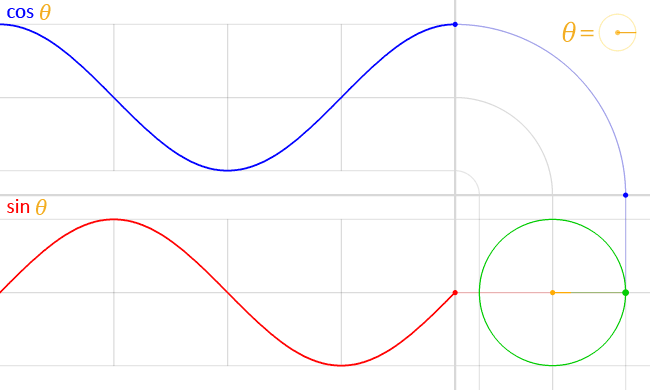

![{\displaystyle {\begin{aligned}\sin(x)&=x-{\frac {x^{3}}{3!}}+{\frac {x^{5}}{5!}}-{\frac {x^{7}}{7!}}+\cdots \\[5mu]&=\sum _{n=0}^{\infty }{\frac {(-1)^{n}}{(2n+1)!}}x^{2n+1}\end{aligned}}}](https://wikimedia.org/api/rest_v1/media/math/render/svg/d9e556638e5bae76e7f002d24327023007673221)
![{\displaystyle {\begin{aligned}\cos(x)&=1-{\frac {x^{2}}{2!}}+{\frac {x^{4}}{4!}}-{\frac {x^{6}}{6!}}+\cdots \\[5mu]&=\sum _{n=0}^{\infty }{\frac {(-1)^{n}}{(2n)!}}x^{2n}\end{aligned}}}](https://wikimedia.org/api/rest_v1/media/math/render/svg/09c2868a6d99b6f581a5d53b177b7b108570c301)















































































![{\displaystyle \cos(zx)={\frac {z\sin(\pi z)}{\pi }}\displaystyle \sum _{n=-\infty }^{\infty }{\frac {(-1)^{n}\,e^{inx}}{z^{2}-n^{2}}},\,z\in \mathbb {C} \setminus \mathbb {Z} ,\,x\in [-\pi ,\pi ].}](https://wikimedia.org/api/rest_v1/media/math/render/svg/4344e0e79e6b3e4af5cabc1ae8ac71054f88e915)


























